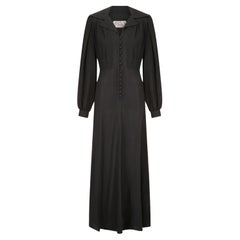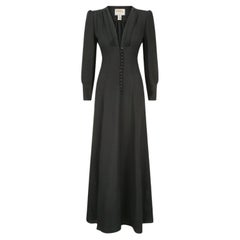Ozzie Clarke
Recent Sales
1970s British Aesthetic Day Dresses
1970s British Formal Wear
1970s British Aesthetic Day Dresses
Ossie Clark for sale on 1stDibs
It’s hardly an exaggeration to say that neither the Swinging Sixties nor the hippie looks of the 1970s would have been what they were if not for Ossie Clark, who popularized the flamboyant fashion synonymous with the eras.
Born Raymond Clark in 1942, the designer moved as a boy to Oswaldtwistle, the source of his lifelong nickname. Clark began studies in architecture at just 13, a foundation that instilled in him the lessons of proportion and scale that would inform his day dresses, suits and other unique clothing decades later.
After learning tailoring, pattern cutting and more important technical skills at the Regional College of Art in Manchester (now the Manchester School of Art), Clark attended London’s prestigious Royal College of Art. There, he began a lifelong friendship with the artist David Hockney, who would eventually paint a portrait of Clark and his wife and partner, Celia Birtwell, also a designer.
Clark’s graduation show in 1964, featuring at least one garment decorated with a line of light bulbs, made instant waves in the fashion world, foreshadowing the career he would have as a boundary-pushing creative. He landed his first feature in British Vogue just months later and was a veritable instant addition to the London fashion scene. While he was still a student, Clark’s designs were being sold in the famous London boutique Quorum, and Henri Bendel had brought his collection to New York. His fashions soon became inextricably linked with the famous “Chelsea Girls” of the decade.
Clark’s clothing ran the gamut from free-flowing garments in muted hues to graphic patterns in bold colors informed by a fascination with Pop art and flora. He collaborated with Birtwell for most of his career, incorporating her dynamic Art Deco–inspired prints in his work before the couple parted in the 1970s. Clark favored crepes and chiffons and paid close attention to small details, often eschewing simple zippers in favor of, say, fabric-covered buttons. At the end of the 1960s, Clark adjusted hemlines to the maxi length and introduced a line of chiffon dresses intended to be worn over a nude body.
Clark’s penchant for flowing pants, bell sleeves and fringe is largely regarded as popularizing the archetype of 1970s fashion in London and the United States — influence bolstered, no doubt, by his dressing such A-list clients as Mick Jagger, Liza Minelli and The Beatles. A gifted draper, he was known for his uniquely flattering fits. As footwear icon Manolo Blahnik once said, “He created an incredible magic with the body and achieved what fashion should do — produce desire.”
Find vintage Ossie Clark evening dresses, blouses, day dresses and more on 1stDibs.
Finding the Right day-dresses for You
Luxurious and versatile, designer day dresses are as well suited to tea at an upscale hotel as they are to your next garden or rooftop party.
Today’s featherlight unisex day dresses — as well as the vibrant vintage day dresses of the 1950s and ’60s — look quite different from the heavy, fabric-rich de rigueur garments of the Victorian era. In the late 19th century, a woman of a certain standing might have multiple dresses to wear throughout the day: specifically, one or two for the daytime and one for the evening. For example, a long-sleeve silk dress with a prominently flared back and a round collar of gold beaded lace that hugs the neck would be suitable for stepping out during the day, while a velvet gown trimmed in silk embroidery but overall comparatively informal in appearance would be worn for afternoon tea at home. At night, a silk velvet evening dress could feature natural world motifs such as butterflies (a characteristic of Art Nouveau design) and have short sleeves adorned with lace and ruffles and a scooped neckline — the perfect attire for the theater.
During the 1920s, after all the chores were done, a woman would change from her housework clothing into a more fashionable day dress to run her errands or socialize. Some 1920s day dresses were brightly colored and featured bold patterns — a cotton dress with a dazzling floral print, perhaps, or, in the case of the more venturesome Art Deco apparel sold in high-end couture fashion boutiques of the era, semi-sheer silk garments embellished with three-dimensional beadwork or rich metallic gold lamé.
Today, a closet full of casual vintage day dresses is a must-have. Whether you opt for black, crimson or beige, day dresses bring an element of glamour to your next appointment, and in the summer, who doesn’t love a wonderfully simple, lightweight day dress cut in cotton and linen?
Because different fashion designers of every decade have offered their own take on the widely loved day dress, you’ll be able to find a variety of vintage and designer day dresses on 1stDibs. Search by creator to find enduring designs by the likes of Emilio Pucci, Pierre Cardin, Yves Saint Laurent and Christian Dior, or browse by period to uncover a scintillating collection of cotton and satin patterned dresses of the 1950s and ’60s.

